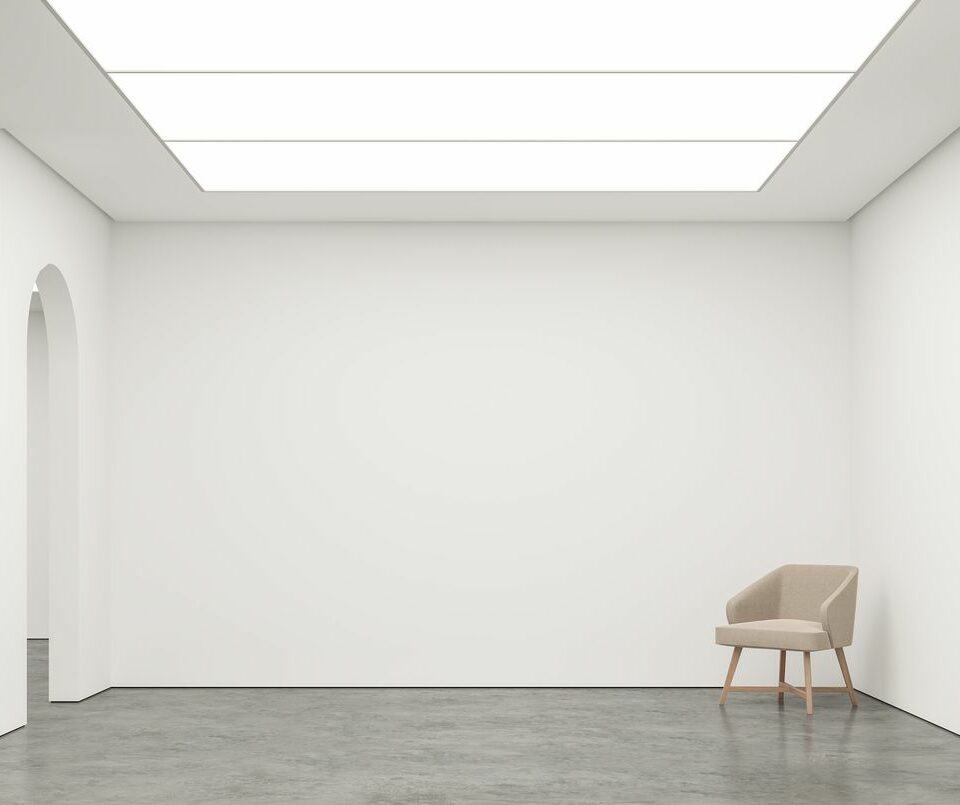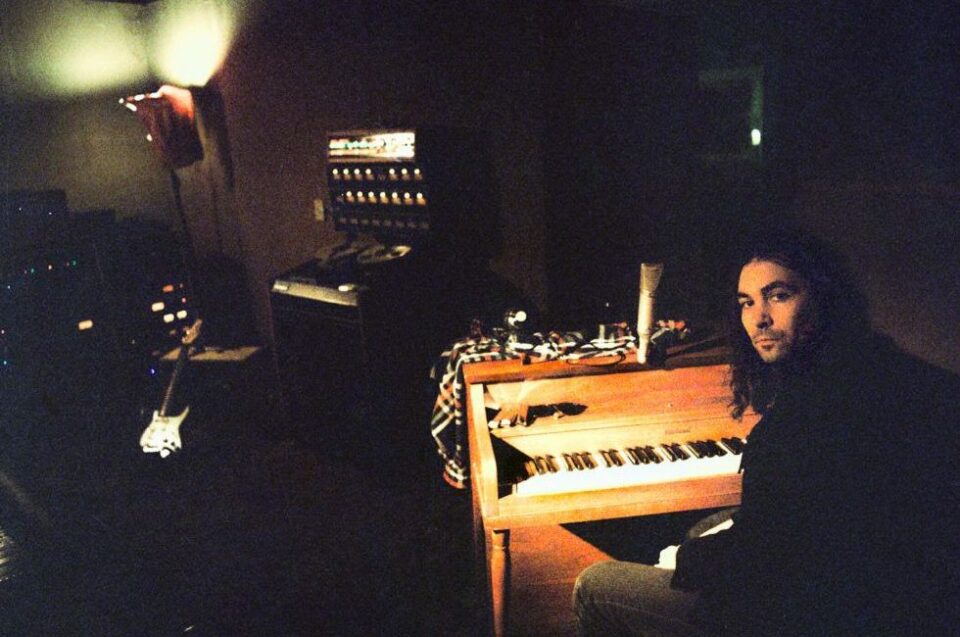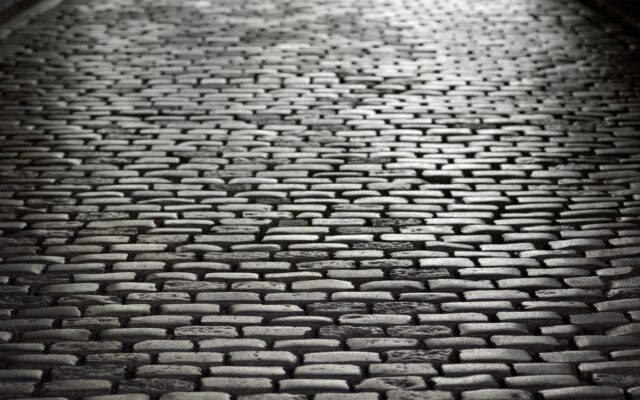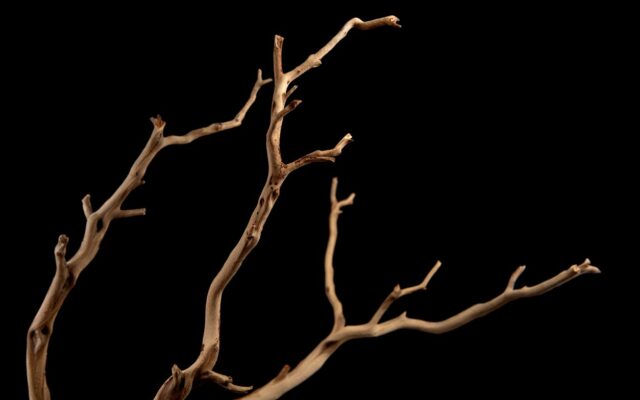Staff had come and gone but no one knew his name or from where he had arrived; no photograph recorded his early years in the place or any previous life he may have led. The man was part of the museum, that much was sure, but no one would have called it his home.
The museum had been built around the rim of a bomb crater, five years after the end of the war. A deep pond now filled the wound. To reach the water’s edge, visitors followed a trail of roses from the museum’s final gallery on the ground floor. Many would congregate around the statue of Our Lady of Miracles – mother and child covered in a rash of grey bullet holes – to reflect on what they had seen inside. It was here that the man spent many afternoons in the warmer months talking to the visitors; at night he stood alone beneath a starry canopy; and in the mornings he strolled the four floors of the glass building which gently curved to form a perfect circle enclosing the pond.
The floor of every corridor and gallery was made from long strips of the lightest pine. The walls behind the paintings were white, and the light streaming through the large glass windows filled every corner of the building. It was left to the art to bring colour to the place – long rows of exotic feasts laid out on a white tablecloth. Each morning the man followed a new path, starting some days in the fleshy baroque of the 17th century, others among the gloomy romantic ruins of the 19th. On reaching the ‘Daughter of Elysium’ he often paused to take in the joyful scene, the young maiden’s waterborne journey to heaven, before he passed through the impressionists and then outside to the pond.
If a tourist happened to share a comment or ask him a question, the man would offer his hand in greeting and politely reply. Regular visitors thought he was a member of staff. His hair now white but still thick and trimmed monthly to an elegant length by one of the receptionists, he might be a retired teacher of art history or simply a volunteer. Students who came to sketch the paintings also began to draw his portrait, and when the architects designed the new extension – a glass tunnel for emerging artists which gradually widened as it stretched out to the forest on the east side – they consulted him for his view, while the cooks in the kitchen tested their new recipes on him, eager for approval. Years drifted away, and the man took on the gentle authority of an uncle, happy to give advice but a little bemused by all this attention.
One of the first directors had wanted him to play a role in the running of the place. She sensed in him a passion for governance and administration, watched him sketch his thoughts on the back of napkins in the cafeteria; not the stuff of regulations for their own sake but the idea, simple as it was true, that through rules we enlarged our freedom. And so it was that, for years to come, the man modestly shaped the day-to-day running of the museum, instilling a sense of order that calmly looked after itself, and each director was as grateful as the last.
The man evidently looked forward to the school visits that arrived from all parts of the continent. When the pupils approached him, he would shake their hand, enquire after their names and answer their questions. If they found themselves before some battle scene from a great war, he would lean forward to recount his own years as a young soldier and describe the unique camaraderie of the trenches, often listing the names of lost friends who never returned, all the while avoiding the truth that he was simply not old enough to have fought in the war.
When a few of the museum guides first noticed this behaviour, no one thought anything of it; the man’s stories were the playful inventions of a grandfather. But then a wider pattern slowly emerged. Several guides began to report the same impression – that the man said nothing about the paintings actually in front of him, or rather he invented stories that had nothing to do with the subject on display. He was both there and someplace else. One of the guides likened it to the man’s daily audiences in the cafeteria, where he gladly talked for many hours without revealing any part of his past. To the director, all this behaviour seemed both troubling and harmless, and then what could she do?
All the museum’s directors had felt responsible for the man’s wellbeing. It was the first who quickly resolved the matter of where he should sleep. Thinking he might be homeless, in spite of a clean raincoat and polished shoes, she found a storage room in the basement that was warm enough; a cheap but comfortable fold-out bed was all the man needed. The director instructed her staff they should share their changing room and showers with him; the man’s clothes were to be thrown each week into the museum’s pile of washing. Staff members took it in turns to bring in fruit, biscuits and cake, while the young men working in the cafeteria provided hot water for the man’s powdered soups. From his first day to the last, his hair was clean and orderly, his breath fresh, and his grey raincoat exposed to the elements only when he took his coffee by the pond.
When the second director and five of his colleagues decided to move into the museum and live there permanently, the man was no longer alone in the evenings. A second extension comprising small bedrooms was built onto the west curve, so that young artists could live there for a semester. The director not only invited the man to take up one of the new quarters but asked him to join the staff as an honorary fellow; the man politely declined and stayed in his basement room. The director still hoped one day to persuade him to take an apartment outside the museum, to lead a more normal life; to keep his special place in the institution but enjoy the freedoms of the city. But here again, without reason, the man always declined.
It was the museum’s 50th anniversary that upset things. The director, number three, had invited the city to a ceremony in two parts. In the morning the pond was drained for the first time in three decades, allowing people to walk down into the cold pit of the crater and inspect its gravelly debris. In the afternoon the grandchildren of soldiers from both sides sat in the main hall, drawing portraits of each other; their work was later displayed along the glass tunnel of the east extension. The man spent the whole of this day in his room. One of the female guides knocked several times at his door but he would only say, from the other side, that he had not come here for “this”. This was not for him, he said, without giving any further explanation. The director was hurt the most: she believed the man would play a central role in the ceremony. One of the resident artists had been asked to draw his portrait, the final piece of the exhibition, which would cast the man as a common grandfather to the children – a simple gesture all the more poignant for the man’s having no family of his own.
But the man took no part in the celebration. He waited for the pond to be re-filled the next day and refused to visit the children’s portraits when they were installed. Over the next weeks he left his room to eat alone in the cafeteria but did little else. The staff tried talking to him but he kept silent. Students brought in their earliest sketches of him, hoping to spark a memory, but nothing stirred him. Time passed and growing numbers of visitors came to the museum so that it was full most days, but the man only became more subdued, his sullen face lost among the busy crowds, his feet trudging the same path each day; he talked to fewer and fewer people. Did he want to leave?, the staff asked themselves.
One morning a man, alone, walked into the museum. He stood for a long moment in the reception area before buying his ticket, his eyes scouring the glass walls as if comparing them to something he had seen in a book. Wearing a light-blue check shirt, brown corduroy jacket and waistcoat, and a pair of cracked leather boots, he might have been a landowner or well-to-do farmer. Sharp white bristles covered his chin, wisps of white hair stuck out from all sides of his head, his eyes patrolled from side to side and his hand gripped a pencil and pad to his chest – a schoolboy with a secret plan.
It was a week later, in the cafeteria, that the newcomer approached our man, the resident. The director spied them from her office and remembered a long, whispered conversation: both men, around the same age, sat there for a couple of hours, ordered several pots of tea and munched through sandwiches while the newcomer scribbled notes in his pad. The resident leaned back in his chair, arms folded, said little; the newcomer kept his voice low but conveyed a grave intensity, his hands chopping the surface of the table, clearing it of invisible objects. Sharing his plans indeed, the director had thought.
The two men settled into a pattern. They met at 11 o’clock each morning, standing side by side in the 18th century, both facing an embattled frigate in a churning sea, its mast shattered by a cannon ball. They shook hands and then the newcomer set off, striding anti-clockwise around the curve of the gallery. He stopped at one of the early works of the 20th century, planted his feet, folded his arms, stared at the painting. Then he giggled. The resident caught up with him, copied his pose, and they giggled together. At the fauvists they laughed long and loud and hard. Among the early cubists they launched a volley of wheezing guffaws, barely able to face the painting in front of them – and then the newcomer chopped the air with his hand, pursed his lips and headed for the cafeteria.
The next week, they met among the expressionist factories and tower blocks. The newcomer opened a packet of prawn sandwiches purchased in the cafeteria, and placed one of them in the centre of the room. The two men faced each other, ten feet apart, the sandwich halfway between them, while the newcomer stared down at the bread, firmly gripping his chin. A few seconds later the other man did the same, and they kept this position for half an hour until a small crowd of visitors had gathered around them. Some began to applaud.
The following day, shortly before closing time, a guard called the director to say she should come to the top floor immediately. She arrived to see huge mounds of Monopoly money piled under every painting in the room, each pile collapsing into small ponds of multicoloured paper on the floor. When she finally caught up with the two men, the newcomer was gleefully thrusting golden five-hundred bills into the hands of staff members, all of whom refused the offer, but he left the room before the director could say anything and then he was gone. The director decided not to take action. As long as they were not hurting anyone or putting the artworks at risk, they were no more than a couple of “harmless eccentrics”, as a local newspaper had described them. Her patience was only tested when the newcomer placed his sandwiches on the guards’ chairs or into the handbags of young female visitors.
But then, one afternoon, a loud sobbing could be heard from the post-war gallery. The director raced to the first floor and found the newcomer standing alone in the centre of the room, surrounded by a dozen visitors, hands over their mouths and their children in tears, while reams of freshly printed Monopoly money flew from the ventilator grill and tumbled over their shoulders, and before the director could begin to imagine how this was possible a bomb-raid siren began to wail from the loudspeaker so that more children began to scream on the floor; the man was now ripping up the money and stuffing it into the coats and jackets and blouses of the small crowd while the resident stood alone at the window, rubbing both his cheeks, looking out.
The newcomer was escorted to the main entrance where he now stood alone on the steps outside, looking back through the glass doors into the museum’s reception area and waiting to see that his partner, the resident, had now arrived. He grabbed more of the coloured money from his coat pocket, ripped it into smaller pieces and threw them into the air like confetti, his arms wide open, eyes looking straight at his partner as if to ask, what are you waiting for?
Alone, the resident faced the exit and looked out into the evening gloom. Reflected in the window he saw the dozen members of staff who had gathered behind him on the steps of the reception area, a choir enclosing its singer.
“You don’t need to go,” said the director, surrounded by her colleagues. “That one is no friend to you. Let him leave with his tears. Try instead to remember why you came here.”
The man looked for himself in the museum’s wall of glass but he no longer saw the white hair and raincoat. Exhausted, his eyes struggling to focus, he thought he could see the broken reflection of a young boy, who was now walking towards him, as if to shake his hand. The man rubbed his eyes while his mind fumbled over the memory like a blind man’s hand on a strange object. He turned around and walked through the lines of staff members behind him, past the director, out of the reception area and over to the large glass door at the back of the hall, where he stepped outside and followed the trail of roses, barely visible in the dark, and stumbled to the edge of the pond. He stood there alone, staring at the water, saw the stars of the night sky reflected on its flat surface, and now discerned another face, familiar, the man who first brought him here a lifetime ago, who held his hand and pointed into the water, asking him to imagine what was there, at the bottom of it all: a kitchen, a staircase, a bedroom and a mother.









